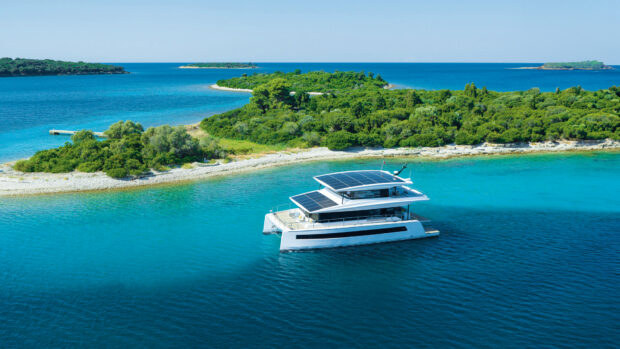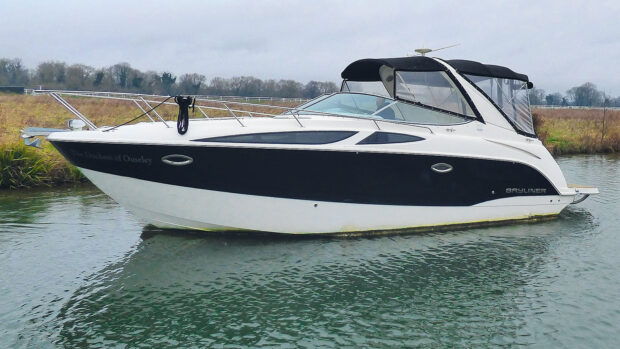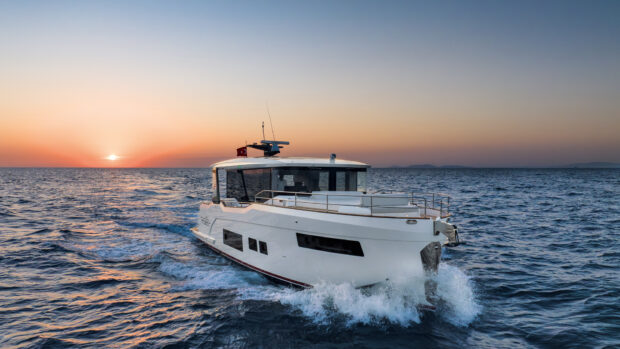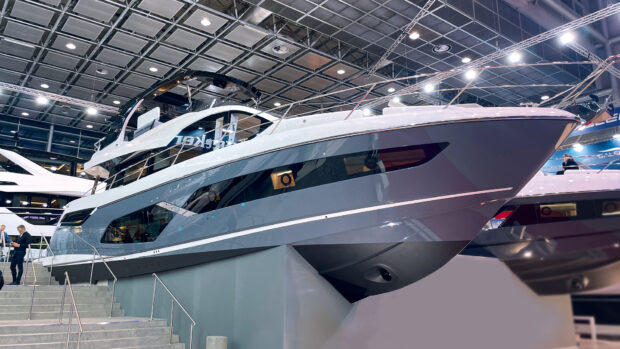Does the Bluegame BGM75 really live up to the promise of providing the best attributes of both monohulls and catamarans? MBY editor, Hugo Andreae takes her for a sea trial to find out
 Watch the video
Watch the videoBluegame prides itself on being different, even its strapline “For Bluegamers Only” makes a virtue of the fact its boats won’t appeal to everyone. It’s this willingness to go against the grain that has resulted in some of the bravest and most exciting designs of recent years, such as the revolutionary aft-facing owner’s cabin of the BG74 and the inside/outside beach club of the BGX65, but this new Bluegame BGM75 is arguably its biggest gamble yet.
Not only is the Bluegame BGM75 Bluegame’s (and parent company Sanlorenzo’s) first ever multihull but it has spent three years and millions of euros trying to ensure that it doesn’t look or feel like one.

Note the relatively narrow gap between the hulls and the central vee designed to reduce the impact of waves passing through it
A power catamaran that tries to disguise its primary asset doesn’t sound like an obvious way to win new customers but there’s solid logic behind this seemingly contradictory premise. Until now the acknowledged benefits of a twin-hulled design, including superior fuel efficiency, a more stable platform and exceptional space above the waterline have been offset by an equal number of trade-offs such as higher berthing costs, boxy looks and reduced cabin space below decks.
Bluegame claims its new BGM75 manages to overcome all these undesirable traits while retaining all the positive ones. In other words it has created a multihull that will appeal to even the most sceptical of monohull enthusiasts.

The lack of fixed guardrails and sidedeck bulwarks may seem odd but in practice it feels very stable and the views out are all the better for it
Two become one
The starting point for this new ‘monocat’ design is a relatively modest beam of 26ft 7in, equivalent to 35% of its 74ft 4in LOA – traditional catamaran designs usually have a beam to length ratio of around 50%.
As well as enabling it to fit into the same sized berth as most large monohulls (rather than needing a double width one), this also shrinks the gap between the hulls, so that they can be connected with the aid of a deeper than usual bridging deck.

The flybridge isn’t huge but its versatile shape, walkaround design and all-glass safety screens make it look and feel unlike any other boat’s
This in turn allows the cabins to be pushed out into the gap between the hulls so that they meet in the middle a few feet above the waterline. In essence this means that the lower deck accommodation now spreads across the full 26ft beam rather than being squeezed into two much slimmer hulls.
When combined with the wider than normal saloon, flybridge and deck spaces, this is said to provide the same level of accommodation as a conventional 90ft monohull but without the associated running costs.
Over the course of 300 engine hours, Bluegame reckons the BGM75 would save around 66,000 litres of fuel and 175 tonnes of CO2 compared to a 90ft displacement vessel powered by larger twin MTU 1,200hp engines.

he saloon is wide enough to feel more spacious than a 75ft monohull’s but not so wide that you can’t converse with people sitting opposite you
Optical illusion
The final piece of the jigsaw is a design team comprising legendary racing yacht naval architect Philippe Briand, to optimise the hulls’ running efficiency, and exterior and interior styling specialists Bernardo Zuccon and Piero Lissoni to ensure it looked and felt every bit as elegant and luxurious as Bluegame/Sanlorenzo’s usual monohull offerings.
We’ll let you be the judge of how well they have succeeded on the visual front; suffice it to say that when viewed from astern, the extended full beam bathing platform and blacked-out transom does such a good job of hiding the gap between the hulls, that you’d be hard pushed to tell it was a catamaran.

No permanent inside helm station but the top of the oval-shaped pillar opens to reveal a set of controls and a single MFD
The illusion holds true from side-on as well, thanks to the stylish, heavily glazed superstructure and reverse angled windscreen that echoes the explorer style vibe of the BG and BGX ranges.
It’s only when you come round the front that the mirage evaporates and you’re confronted with the unmistakable gaping mouth of a rather bloated looking powercat, caused by the deep bridging deck that links the two hulls.
In fact, the addition of a central vee at the front of this deck to reduce the impact of waves passing between the hulls, means it could be mistaken for a trimaran at first glance. There’s nothing wrong with that but we suspect it’s no coincidence that Bluegame’s marketing majors on aerial shots of the stern and side with a notable absence of low level front-on shots.

Oversized bathing platform, folding wings, raised cockpit and tender garage create a beach club vibe and help hide the gap between the hulls
Deck delights
There’s no doubt that it feels pretty special too. That big teak bathing platform can be extended even further with the aid of two folding side terraces, while the transom hides an unusually tall tender garage (large enough for a mini-RIB, paddleboards, Seabobs, bicycles and sunpads) that, once emptied of its cargo, becomes part of the wider beach club area. A central section of platform then lowers into the sea, revealing a folding staircase giving access for guests.
Because of that tall tender garage, the aft cockpit sits a couple of feet higher than normal and, instead of the usual fitted furniture cluttering up the space, it’s left as a blank teak canvas that can be accessorised with whatever fixed or free-standing furniture the owner chooses. We weren’t wholly convinced by the test boat’s island sofa as all the guests end up facing away from each other.
Another benefit of this extra height is that the whole aft end of the main deck is on one level so the cockpit segues seamlessly into the sidedecks. These are wider than you’d find on most monohulls but not so wide that they steal space from the saloon.

Note the distinctive curved deckhead and cantilevered ‘floating’ bed that give the full beam owner’s cabin a completely different feel to any other monohull or catamaran design we’ve come across
It’s only when you reach the side doors leading into the forward end of the saloon that you’re confronted with four steps leading up to the raised foredeck area. Once again this feels very different to the bow lounge of a modern monohull, partly because of its considerable extra width, most of which is occupied by a vast central sunpad, but also because there are no guardrails across the bow, no bulwarks along the sides and only removeable carbon fibre stanchions and ropes keeping you fenced in.
Traditionalists may not approve but thanks to the natural stability of the hull, a secure recessed seating area forward and acres of warm, grippy teak underfoot, it feels safe enough and looks stunning.
Moving up a level to the flybridge, via a very elegant curved teak and steel staircase, reveals another teak party platform. Once again it’s the shape rather than the size of it that feels quite different. Instead of the usual long thin flybridge zoned off into helming, dining, bar and lounge areas, it’s all one big space that can be configured how you wish.

The guest cabins all have their beds mounted up high in the space between the hulls. The side bulkheads could do with some colour or texture to break up the rather large blank surfaces
The only fixed furniture on the test boat was the helm pod, which floats above the deck on a couple of slender pillars, the triple leaning posts behind it and a central wet bar area housing the usual fridge, ice maker, grille and sink. The rest of the space was filled with freestanding sofas, tables, chairs and sun loungers. It all makes for a very relaxed, free-flowing, sociable vibe.
It’s a very similar story in the saloon, whose shape it closely mirrors. The big surprise is the lack of a dedicated inside helm station. You can still drive it from here, using the joystick, MFD and thruster controls, mounted under a folding cover next to the dining area, but without any seat or leaning post to rest against it’s hard to see this being used for any length of time.
There is an option for a galley up layout, which also makes space for a fourth cabin down below, but our boat was clearly set up for a professional crew with most of the starboard hull being given over to a big galley, crew mess and cabins for the captain, chef and deck staff.

Three of the latest Garmin GPSMAP 9000 MFDs give exceptional clarity
Cabin comforts
If the day-time entertaining spaces feel subtly different, the cabins are from another planet. The owner’s suite is unlike anything we’ve ever seen before. Spanning the full width of the boat, but all on one level rather than dropping down into the hulls, and featuring an extraordinary curved forward bulkhead that blends seamlessly into the deckhead, it feels like you’re standing inside a large cream and teak-lined cavern.
Even the aft-facing bed seems to float on thin air, projecting into the space on a cantilevered support from an equally voluptuous curved wooden ledge. The ensuite bathroom occupies one end of this almost tubular space with a corrugated glass bulkhead and doors allowing light to filter through from the white tinted hull windows at both ends. There’s even a large walk-in wardrobe next to it.
The other two guest cabins are both in the port hull but because of that deep bridging deck the beds are mounted above the space between the hulls, allowing them to face out towards the portholes and leaving masses of floor space at the foot of the beds but no standing room alongside them.

It’s a clever solution that makes the cabins feel very voluminous, even if much of that space can only be used for sleeping. Both have their own sizeable ensuite bathrooms. The fourth cabin, if you opt for it, is a mirror image of the forward port one.
Twice as good?
Although we only had a relatively brief opportunity to drive it within the confines of the Bay of Cannes, we did get a full set of performance and fuel economy figures and enough time at the helm to put its claims to the test.
The first thing to note is that our test boat was powered by what was at the time the most powerful engine option of twin Volvo IPS800s of 625hp each. Since then the standard engines have been uprated to 800hp IPS1050s with the option of upgrading to 900hp IPS1200s so both the performance and fuel consumption are likely to go up by around 10%.
With the smaller IPS800s, we recorded a top speed of exactly 20 knots, giving a realistic fast cruising speed of 16-18 knots. Even at this speed the BGM75 was burning less than 12.5
litres per mile, compared to 17.9lpm for an Azimut Magellano 25M or 22.5lpm for a Sunseeker Ocean 90.

Curved staircase at the front of the saloon leads down to the owner’s cabin, day heads and galley/crew area in the starboard hull
At displacement cruising speeds the gap narrows a bit but at 10 knots the BGM is still burning just 4.7lpm compared to the Magellano’s 8.27lpm and the Sunseeker’s 6.6lpm.
That relaxed cruising nature is largely reflected in the way it handles. With no planing ‘hump’ to climb over you can choose whatever speed you wish to cruise at without affecting the boat’s trim or ride comfort. The boat was too full of people to record an accurate set of decibel figures but with those relatively small engines and famously smooth IPS drives tucked well away
from the helm and entertaining spaces, it felt and sounded very refined right through the rev range.
While not as fine as some power catamarans’, the twin hulls did a good job of cutting through surface chop and riding over longer frequency swells, resulting in a comfortable ride without any obvious sign of the abrupt crabbing motion that can affect some powercats in quartering seas.
It was only when we encountered a boat wake tall enough to impact the low-hanging bridge deck that the peace was broken by an abrupt shudder. You’d really need to sea trial it in a variety of more challenging conditions to see if this was a frequent and/or unsettling occurrence or just an occasional irritation.
Bluegame BGM75 specifications
LOA: 74ft 4in (22.70m)
BEAM: 26ft 7in (8.15m)
DRAFT: 4ft 3in (1.30m)
DISPLACEMENT: 48 tonnes
FUEL CAPACITY: 5,000 litres
WATER CAPACITY: 1,000 litres
BLACK WATER: 500 litres
RCD Category: B for 16 people
CONTACT: bluegame.it
Price as reviewed:
£5,786,766.00 Base price ex. VAT
Verdict
Has Bluegame achieved what it set out to do and created a boat that combines all the positive attributes of a multihull without any of the drawbacks? Up to a point. It certainly looks very stylish and feels less daunting than a conventional wide beam motor cat, while that clever lower deck design makes the cabins feel more spacious too. The fact that it manages this while still using considerably less fuel than a planing monohull, albeit at the cost of some top end speed is another significant win. Whether it really feels as spacious and capable as a 90ft monohull, especially in bigger seas, is another matter. What it does do is look and feel very different to anything else in the market, delivering a unique combination of style, space, quality and efficiency that might well appeal to a wider group than the usual “Bluegamers only”.









